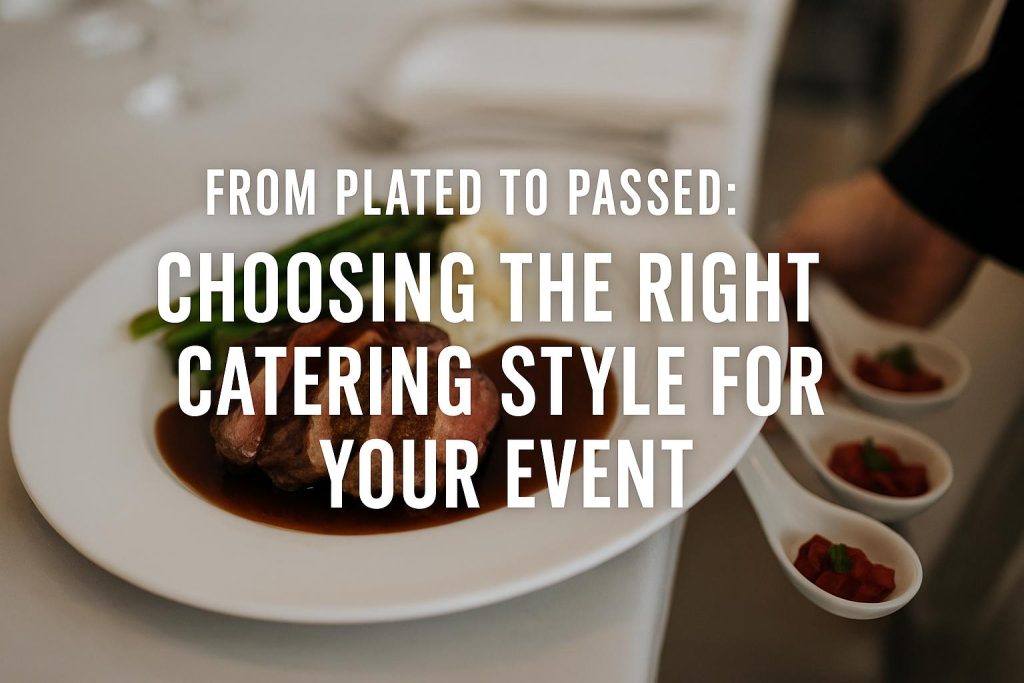
When planning an event, whether it’s a wedding, corporate gala, milestone birthday, or charity fundraiser, the menu is always top of mind. But equally important as what you serve is how you serve it. The catering style you choose sets the tone for the entire event, impacting everything from ambiance and flow to guest experience and budget.
With several service options available, plated dinners, buffets, food stations, and passed hors d’oeuvres; it’s essential to select a catering style that matches your event’s size, vibe, and objectives. This guide breaks down each option to help you make a confident and delicious decision.
1. Plated Dinners: Elegant and Structured
Overview:
Plated service is the most formal catering style. Guests remain seated while servers deliver each course; typically a starter, main entrée, and dessert. Everyone is served simultaneously, which adds a sense of cohesion and structure to the meal.
Best For:
- Formal weddings
- Fundraisers and galas
- Corporate awards banquets
Pros:
- Elegant and refined presentation
- Predictable timing and flow
- Easier portion control and cost predictability
- Ideal for speeches, performances, or scheduled programming
Considerations:
- Requires more staff, increasing labor costs
- Less flexibility in meal options (usually 2-3 entrée choices offered in advance)
- Seating must be planned and assigned
Pro Tip:
Offer guests a pre-event meal selection when sending invitations to ensure service runs smoothly.
2. Buffets: Flexible and Familiar
Overview:
Buffets offer a self-serve experience where guests can choose from a spread of entrees, sides, and desserts. This is a popular style for mid-sized events and those that prioritize flexibility.
Best For:
- Family reunions
- Graduation parties
- Casual weddings and corporate luncheons
Pros:
- Offers variety, great for accommodating dietary restrictions
- Encourages mingling and casual conversation
- Generally more budget-friendly than plated dinners
Considerations:
- Can lead to longer wait times at the buffet line
- More food waste if not monitored
- Requires sufficient space for setup and guest flow
Pro Tip:
Consider having duplicate buffet lines on either side to keep things moving, especially for larger groups.
3. Food Stations: Interactive and Trendy
Overview:
Food stations are like elevated buffets, with each station focusing on a specific cuisine or dish type; like pasta, carving, tacos, or sushi. Often attended by chefs or staff who prepare dishes to order.
Best For:
- Cocktail receptions
- Holiday parties
- Rehearsal dinners
- Events that emphasize entertainment and interactivity
Pros:
- Encourages guest movement and conversation
- Customizable and highly engaging
- Perfect for showcasing culinary creativity and live cooking
Considerations:
- Can be more expensive due to staffing and equipment needs
- Requires significant space and layout planning
- Not ideal for very formal events with tight seating arrangements
Pro Tip:
Mix and match 2–4 stations to offer variety without overwhelming guests.
4. Passed Hors d’Oeuvres: Chic and Social
Overview:
Servers circulate the room offering bite-sized appetizers on trays, often during a cocktail hour or a reception-style event without a formal sit-down meal.
Best For:
- Gallery openings
- Networking events
- Cocktail receptions
- Pre-dinner gatherings
Pros:
- Encourages mingling and conversation
- Elegant and sophisticated presentation
- Pairs well with open bars or signature cocktails
Considerations:
- May not be filling enough for meal-replacement unless quantity and variety are substantial
- Labor-intensive due to the number of circulating staff needed
- Guests might miss selections if the flow isn’t managed well
Pro Tip:
Combine passed hors d’oeuvres with stations or a late-night snack bar for a more satisfying overall experience.
How to Choose the Right Catering Style
When deciding which catering style fits your event best, ask yourself the following:
- What is the tone or theme of the event? A black-tie affair calls for plated elegance, while a casual garden party might be perfect for a buffet.
- How many guests are attending? Large groups benefit from buffets or stations to avoid overwhelming kitchen staff and timelines.
- What’s your budget? Plated meals and interactive stations tend to cost more, whereas buffets and passed apps offer more flexibility.
- How long is your event? For shorter receptions, passed hors d’oeuvres or stations keep the energy up without requiring long seated periods.
- What space is available? Plated dinners need structured seating, while stations need room for movement and setup.
Ultimately, the best catering style is one that enhances the guest experience, aligns with your vision, and fits seamlessly within your event’s logistics.
Combine Styles for Maximum Impact
Don’t feel limited to just one service method. Many successful events incorporate a hybrid approach, such as:
- Passed hors d’oeuvres followed by a plated dinner
- Buffet dinner with a dessert station
- Interactive stations with passed small plates throughout the evening
Mixing styles can offer a memorable experience that’s dynamic, inclusive, and tailored to your event’s goals.
Make Your Event Effortless and Elegant with Plate Perfect Catering
At Plate Perfect Catering, we believe that every event deserves a menu and service style that’s as thoughtful as the occasion itself. From sophisticated plated dinners to vibrant food stations and everything in between, our expert catering team helps you select the perfect style for your needs, guests, and vision.
Let’s craft a catering experience that’s delicious, stylish, and absolutely unforgettable.
Visit Plate Perfect Catering to explore our full-service offerings and request a custom consultation today.

